 A visit to a Chinese garden is a very different experience than visiting an American or European one. Like many other art forms of China, garden design is closely related to Chinese philosophy especially in regard to the essence of nature. If you have ever studied Chinese landscape painting you probably heard this same statement because Chinese landscape painting and garden design have a great deal in common. In fact, Chinese landscape painting and garden design, together with poetry and calligraphy are considered interdependent arts, each enhancing the others.
A visit to a Chinese garden is a very different experience than visiting an American or European one. Like many other art forms of China, garden design is closely related to Chinese philosophy especially in regard to the essence of nature. If you have ever studied Chinese landscape painting you probably heard this same statement because Chinese landscape painting and garden design have a great deal in common. In fact, Chinese landscape painting and garden design, together with poetry and calligraphy are considered interdependent arts, each enhancing the others.
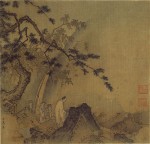 If you look at a Chinese landscape painting you can get an idea of what the Chinese have traditionally thought about the relationship of man and nature. The small size of the people relative to the landscape suggests that they are subordinate to nature. They are part of nature, responding to its cycles as all living things do. Chinese garden design blends nature and man-made structures to create an environment where balance and harmony reflect the concepts of yin and yang, the contrasting yet complementary energies that cause everything to happen. The goal is to provide a place for contemplation where a man can become intimate with nature and in contact with the forces of the universe.
If you look at a Chinese landscape painting you can get an idea of what the Chinese have traditionally thought about the relationship of man and nature. The small size of the people relative to the landscape suggests that they are subordinate to nature. They are part of nature, responding to its cycles as all living things do. Chinese garden design blends nature and man-made structures to create an environment where balance and harmony reflect the concepts of yin and yang, the contrasting yet complementary energies that cause everything to happen. The goal is to provide a place for contemplation where a man can become intimate with nature and in contact with the forces of the universe.
Needless to say, the Chinese philosophy behind the arts is far more complex than this but the good news is that you don’t really have to understand Chinese philosophy in order to enjoy a Chinese garden. An awareness that a Chinese garden is going to be very different from a western garden and the willingness to appreciate the differences are all that is needed.
If you visit a classical Chinese garden, don’t expect to see a symmetrical layout, extensive areas of lawn, long vistas and panoramic views, avenues of trees or shrubs, flowers gathered in beds, or water flowing from elaborate fountains. Do expect to see the four elements, water, stone, plants, and architecture, arranged asymmetrically along a winding path so that the landscape is revealed a little bit at a time as if it was painted on a horizontal Chinese scroll.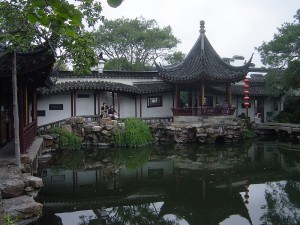
Everything in a Chinese garden is symbolic and can be enjoyed on many levels. Water represents the soft, yielding aspects of Yin, the life giving energy of the universe.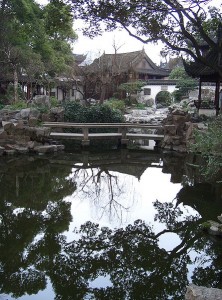
Stone balances the Yin energy, representing mountains and Yang energy. It is used like statues are used in European gardens.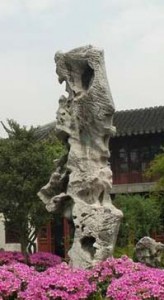
The plants are symbols of human qualities such as purity (lotus), endurance (pine), power (peony) and flexibility (bamboo).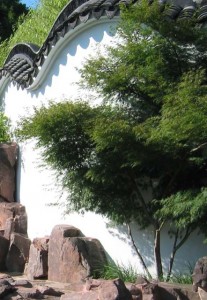
The architectural elements may be varied and include bridges,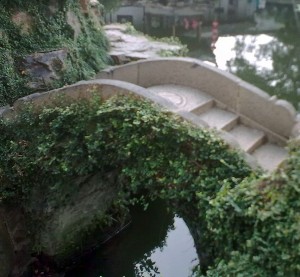
pavilions that provide the best views,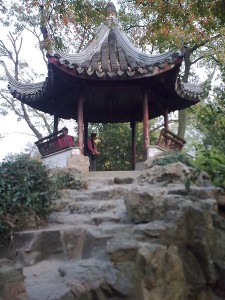
moon gates that frame unique areas,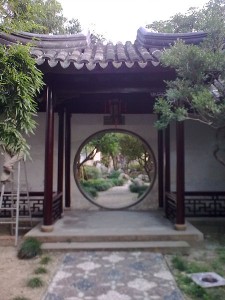
and screened windows that suggest steadfastness and movement as they reveal special garden scenes.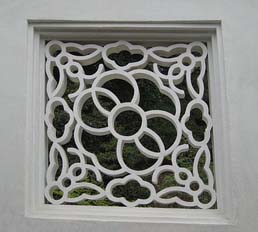
The classical Chinese gardens, typical in the south, were usually small compared to the huge imperial gardens of the emperors in the north. They were built by wealthy merchants and scholars who enjoyed their garden alone or with friends often in conjunction with poetry readings and literary discussions. Parts of the garden were sometimes inspired by lines from favorite poems or conversely, certain aspects of the garden inspired the creation of poetry. Most importantly, the garden gave its owner a place to meditate, develop his inner feelings towards the landscape, and come to an understanding of the unity of creation.
After you have visited several Chinese gardens you may think that they are very much alike but they aren’t and many visits may be needed appreciate the subtle differences. Each garden employs the same basic elements but they do so in different ways so that a different balance and harmony is achieved in each garden. Some have more water, others more rock; some use more plants, others feature more pavilions and so on. Each garden is an expression of the way the designer interacts with nature and the elements he has to work with. The Chinese experience nature differently than westerners leading to a very different kind of garden, but one that can be enjoyed by anyone who desires to do so.
